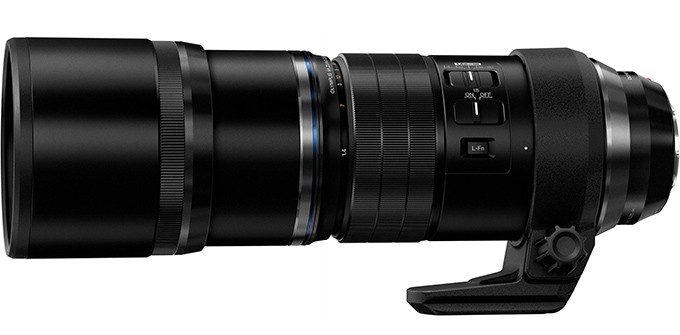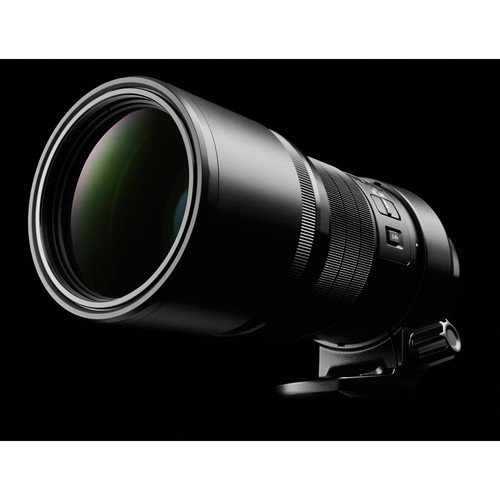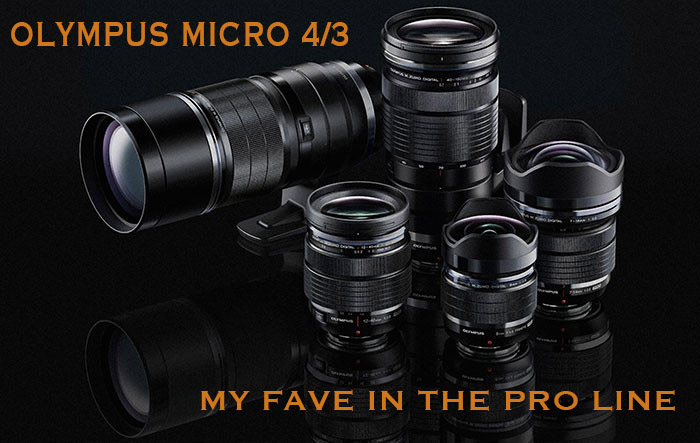The New Olympus 300mm f/4 Pro Lens! Holy Telephoto!
Olympus has announced a new lens for the Micro 4/3 system in the form of a 300mm PRO f/4 Prime lens, and believe me..this lens will be quite special. Think about it. This lens will deliver a 600mm equivalent on your micro 4/3 body giving massive reach. Between Olympus and Panasonic we have some of the best lenses in the digital photo world available to us. The new 300mm PRO lens is available NOW for $2499 in the USA and $3299 in Canada. I think this lens will make many Micro 4/3 shooters VERY happy as this will offer a level of performance at the top of the heap. Olympus knows how to make amazing glass.
YOU CAN ORDER THE NEW 300 F/4 PRO LENS AT B&H PHOTO – HERE.
I look forward to reviewing this beautiful piece of glass. SOON 😉
PRESS RELEASE FROM OLYMPUS:
A NEW WORLD OF HANDHELD NATURE PHOTOGRAPHY: THE OLYMPUS M.ZUIKO® DIGITAL™ ED 300MM F4.0 IS PRO ARRIVES
Super Telephoto Lens with Powerful 5-Axis Sync Image Stabilization and Olympus’s Highest Resolution Ever in a Compact, Dustproof and Splashproof Body
CENTER VALLEY, Pa., January 5, 2016 — Olympus is pleased to announce the Olympus M.ZUIKO Digital ED 300mm f4.0 IS PRO, a compact super telephoto lens that expands the capability of the M.ZUIKO PRO series of professional, splashproof and dustproof lenses that deliver outstanding image quality under any circumstance. The M.ZUIKO Digital ED 300mm f4.0 IS PRO is the first Olympus interchangeable lens with a built-in image stabilization mechanism, and when paired with the Olympus OM-D E-M1 (firmware version 4.0) or E-M5 Mark II (firmware version 2.0), in-body and in-lens image stabilization work in perfect harmony, resulting in the new 5-Axis Sync IS technology to produce the world’s most powerful image stabilization performance of up to six shutter speed steps of compensation*.* The lens can also be used effectively with other camera bodies, as the in-lens stabilization mechanism alone provides four shutter speed steps of compensation.
With a length of 8.9 inches (227mm) and weight of a mere 2.8 pounds (1,270g), at one-third of the size and weight of most DSLR 600mm equivalents, the M.ZUIKO Digital ED 300mm f4.0 IS PRO is designed to slip into an airplane carry-on bag or backpack and go anywhere to help users easily capture handheld images in once-challenging photo destinations. Despite its compact size, the lens is hermetically sealed in 17 places and features freezeproof performance down to 14⁰F (-10°C). Together with the same splashproof, dustproof and freezeproof performance as the OM-D E-M1 and E-M5 Mark II, this ensures you can capture high-quality images in the harshest environments.
The M.ZUIKO Digital ED 300mm f4.0 IS PRO debuts Olympus’s highest-ever resolution by combining three Super ED lenses, one Extra-High Refractive index lens and three High Refractive index lenses to reduce the color bleeding and chromatic aberrations that tend to occur on typical super telephoto lenses. In addition to Olympus’s renowned ZERO Coating (ZUIKO Extra-low Reflective Optical Coating), a brand-new lens coating technology called ZERO Coating Nano suppresses reflected light to minimize ghosts and flares for extremely sharp details of images, including car headlights. A layer of nanosized particles and a layer of air from the center to the surface of the lens achieves a refractive index similar to air and significantly reduces surface reflection.
The M.ZUIKO Digital ED 300mm f4.0 IS PRO also gets up close to explore the beautiful, minute world of telemacro photography with maximum image magnification of 0.48x (35mm equivalent), with a minimum focusing distance of 46 inches (1.15m) from the end of the lens. When combined with the M.ZUIKO Digital 1.4x Teleconverter MC-14, the user can capture all of nature’s beauty in high resolution at 840mm (35mm equivalent) and an increased image magnification of 0.67x (35mm equivalent) in a handheld compact body while maintaining the same minimum focus distance.
The OM-D’s silent mode combines with the lens’ Movie & Still Compatible mechanism for silent AF and shooting, giving the user the ability to blend into the background of any situation, whether that be the refinement of a symphony performance or the dusty plains of a lion’s hunting grounds.
The lens also features a Manual Focus Clutch mechanism that makes switching to manual focus possible by pulling the focusing ring toward you. The side of the lens barrel features a Focus Limit switch (4m to infinity, all range, 1.4 to 4m), an IS switch (On/Off), and an L-Fn button, which can all be operated without ever taking your eye off the viewfinder. The built-in sliding lens hood can be locked into place when extended, and the tripod base plate with a quick shoe compatible rail is removable.
U.S. Pricing and Availability
The M.ZUIKO Digital ED 300mm f4.0 IS PRO lens is available now for an estimated street price of $2,499.99 (U.S.) and $3,299.99 (Canada).
*As of December 2015. CIPA guideline compliant, when correction is carried out on two axes (yaw and pitch) and when halfway release image stabilization is off.
ABOUT OLYMPUS AMERICA INC.
Olympus America Inc. is a leading provider of digital imaging and audio technology solutions, noted for its precision optics and groundbreaking technologies.
For more than 90 years, Olympus has innovated and developed best-in-class products that expand the boundaries of product design and functionality, empowering consumers and professionals alike to capture their stories. These include:
Digital Compact Cameras
Professional and Consumer Interchangeable Lens Cameras
Related Underwater Products and Accessories
Digital Audio Recorders
Binoculars
Accessories
For more information about Olympus and our award-winning products, please visit getolympus.com or connect with us and other fans like you through our social and photographic communities: @getolympus on Facebook, Twitter, Tumblr, YouTube, Pinterest, Instagram and Flickr.
Specifications and design are subject to change without any notice or obligation on the part of the manufacturer.
All trademarks and registered trademarks listed herein are the property of their respective holders, in the U.S. and/or other countries.
Copyright © 2016 Olympus America Inc.
# # #







My wife has been a gem! She helped me to buy the 300mm f4 Pro. A lot of money; £2,199 in the UK, but worth every penny. It really is a stunningly good lens; very, very sharp, incredibly impressive IS and easily hand held for birds in flight (BIF). It also works well with the Olympus EC-14 tele converter, but of course 1 f-stop is lost. My camera is the OM-D E-M1.
As a comparison of sorts, my previous system was Canon 5D and 500D with the Canon 100-400mm L series lens. The Oly system for tele photography is far superior in having much better IQ and ease of use. BIF was near impossible with the Canon set up.
It took a little while to establish what settings to use on the camera. I have found that with the M1, focus tracking can be a bit hit and miss, especially with fast moving birds which can only sensibly be photographed hand held. For the time being at least, I have found that Continuous AF works well in conjunction with Sequential H frame rate. Also, when shooting against a clear sky set the focus points to the maximum, and ESP or centre weighted metering. I would appreciate some insight on what other people have found to work for BIF.
The only downside of the 300mm is that it gobbles batteries. I have just bought the HLD-7 battery grip; this sorts that issue out! For the price it would have been good of Olympus to supply the lens in a proper padded case, not the thin soft thing it comes with. I bought a Lowepro for it.
Bottom line: if you have any doubts about the lens performance and quality; forget them, it’s a superb piece of gear.
I forgot to mention the ‘lens function’ button. For hand held work I sit the tripod mount on the palm of my hand with fingers and thumb around the lens. This means that my thumb just happens to be right where the ‘lens function’ button is. So, if the button is active for a function, it can be accidentally activated – really annoying.
I know some may say, ‘why not swing the tripod ring up out of the way’. I prefer it the way I do things.
I have all 4 ‘My Sets’ set up for different work types; for BIF I have set the lens function button to Off.
I have also found it handy to flip the focus ring back for manual focus if the continuous AF is hunting, and set peaking with red outline and 3x magnification, then immediately flip the ring back to autofocus – it works for me.
I’ve had my 300mm f4 Pro for a week and am having a very steep learning curve with all of the features and capabilities. That said, I’m very happy with the image quality. The lens is fearfully sharp and balances nicely on my E-M1. The image stabilization is phenomenal. Once I get used to it and build up the strength in my left arm a bit, this lens will get heavy use.
I had to get a new bag to hold this longer lens (Peak Design Everyday Messenger 15), so be warned that the lens purchase doesn’t necessarily put a stop to your spending. ;^)
I purchased the Panasonic 100-400mm about 5 days ago. Life is pretty busy at the moment so I haven’t haven’t been able to put much time in with it. However my initial impression is that it is well worthy of the Leica stamp. Most of the images that I have taken are between 350mm and 400mm at f6.3 which is where I suspect most people would want to use this lens. Without having done a direct comparison I think it is at least as good as the Olympus Zuiko 50-200mm which is regarded as a classic 43rds PRO lens.
The extra 100mm reach should mean not having to use tele-converters in most circumstances. Further, being able to crop the image in the camera should save having to crop at a later stage and help get the most out of the m43rd sensor. I think that this is an often overlooked advantage of doubling the effective focal length of a lens with the smaller sensor. Cropping a full frame or APS-C image to approximately the same area as 43rds means you have lost much of the advantage of the larger sensor. I may be wrong, however I suspect that focusing accuracy improves slightly if the subject is where it appears in the final image, i.e. a bit closer and larger in the viewfinder.
Build quality is very good and the lens has a good feel without being overly heavy. Colour rendition is excellent as you would expect, and the bokeh is pleasant where the subject is reasonably close.
Whilst the new Olympus 300mm may well prove sharper, I think that the 100-400mm will prove highly competitive in most circumstances as well as very versatile and convenient, particularly where weight and size are an important consideration. Being able to lock the zoom at any focal length is a really great feature and stops zoom creep. It also makes the lens feel like a fixed focal length to use.
As Steve remarks it is a great time to be using m43rds gear. We are finally getting some really good options.
Still waiting for it to actually be available! Anyone know of the date one can order it–and get it shipped?
The 300 MM F/4.0 is now available. They might even be sold out at dealers by now. I am so
delighted with its image qualities and will be putting it to heavy use in Florida in about 5 weeks
from now. I can hardly wait.
I’ll admit to being disappointed by the physical specs of this lens. I changed to an Olympus E-M1 from Nikon, because my Nikon camera (D300s) was feeling too heavy and clumsy in use. Now Oly seem to have gone against their lightweight ‘ethos’ by producing one of the largest and heaviest 300mm f/4 lenses around!
The current Nikon 300f4 is much smaller and lighter and I feel that a lens of this design could cover an MFT sensor with excellent results, so why have Oly introduced a lens that is so much heavier?
It’s silly to compare the lens, physically, with a 600mm full frame lens – this is a 300mm lens working with a cropped sensor.
Mike
You will get a 600mm POV, and I have never seen IQ from any 300mm f/4 this good. I had a chance to test it and I was blown away by it and the fact that the IS in body and the lens work together to give you MUCH MORE handholding Ability than ANY Nikon 300mm. Also, shooting a Nikon 300 on a Nikon will give you a 300mm magnification, NOT 600 as this will. So while it is a 300mm lens, on M 4/3 you DO IN FACT get a 600MM FOV. No 300mm lens on Nikon will do this. Finally, the construction quality and attention to details on the Olympus far surpass the Nikon. From build, sealing, super smooth built in hood, etc. This lens is stunning.
I’m not doubting the IQ and build – I just wish Oly had pulled something lighter out of the hat!
I’ll be interested to see how the Leica/Panasonic 100-400 performs, when it appears.
I understand. I think making it smaller would have compromised IQ or the IS. It is a pro lens, so full sealing as well. If they compromised, it would not be nearly as good as it is. So its always a compromise it seems.
Steve, Your comments on the Olympus 300 MM F/4 is right on the money. I have this lens now for about a month and the image quality is absolutely stunning. I haveshot
and enlarged images to 200% and they are razor sharp. Actually superior to the super
40-150 F/2.8 zoom by a fair amount. I am greatly impressed
I have been waiting for over a year for this lens and have it pre-ordered at a local camera store to go with my EM-1 however after going out shooting some birds in flight with my current 300mm from Oly and being so very disappointed with my results, and the consensus from the gathered group was that the new 300mm pro won’t help much and I need to go down the Canon route.
I’m sooooooo torn and have yet found an Oly owner that disputes this. 🙁
Hi Steve!
I too am hoping you will manage to do a side by side comparison between this and Panasonics new offering. I am currently planning a trip to new Zeeland this fall and I already think about what lenses to bring with my wonderful EM-1.
Cheers!
Steve, I ordered and paid in full last June for my 300F/4 so I could be first in line at my dealer. I am
Currently using my 40-150 zoom and from what I see of sample images, I am going to be in 7th heaven. I can hardly wait. I already have the 8MM, 7-14 MM, 12-40 MM, and 75 MM 1.8 and have
since dropped my extensive Nikon D-750 and large lens system for the Olympus OMD-5 Mk 2. I am
Very happy with my new Olympus equipment.
Steve, when reviewing this lens, it would be extremely interesting if you could arrrange a direct side to side comparison to the Pana-Leica 100–400!
After a point, bigger sensors do not make any sense. So, up to a certain FOV, medium format is ace, but then you have to step down to 135, and after a certain FOV you have to step down to half-frame (APS-C), and then Micro 4/3.
Either that, or you keep the bigger sensor but keep the aperture modest as your lens gets longer (modern sensors make wide apertures redundant).
“modern sensors make wide apertures redundant” – what happens when I wan’t shallow depth of field?
This lens does look good – wondering what I’d lose using on my EM5 Mk 1?
You’d miss out on Phase detect autofocus which is better for objects moving towards or away from you.
I wonder how this lens would preform for shooting race cars at speed.
What is the “perfect” camera to put this lens on?
As of now, E-M1. Soon, E-M2 or MKII as I am sure that the new pro body is coming..I can feel it.
Great for wildlife and bird photography.Sure Canon and Nikon are the preferred kit but I can see the merit of such a compact kit.
Used to use a Pentax k 1000 and a Pentax 300 mm f4 Takumar for bird photography back in the day. Modern cameras and lenses really have made life easier.
Goodness this lens sounds phenomenal! Clearly Olympus are leading the way.. Just look at those specs! The impressive IS interests me, and I wonder if 6-stop shake reduction will also be possible with the Panasonic GX-8 body?
Is there a market for $2500 lenses in the micro format? I’m sure it’s great but who would buy this?
The point of micro is small size. Once that has been removed, why deal with the smaller sensor?
Bigger lenses handle better with bigger bodies, which have the bonus of having better sensors.
Sure there is. This lens will give results that will blow your mind away. Just like their 40-150 does, but even better. A 600mm reach – this will sell very well. I already personally know 6 people who ordered it yesterday and today.
The new 21MP Nikon D500 DX camera plus the new Nikkor 200-500/5.6 lens (fixed aperture) will cost you only $3,400. Cheaper than the Oly set up with better AF tracking and longer, more flexible reach.
Once you slap these big lenses on the micro cameras you lose the only benefit – size, and now have to deal with higher cost and lower IQ.
Well, the Nikon will not have faster AF. Even the E-M1 will AF as fast or faster and believe me, a new Oly pro is coming. The Nikon I would never ever want. It is a DSLR, same old clunky fat body, same old crap OVF, same old Nikon in general. Also, NO 200-500 5.6 can outperform this 300 f/4. Wait and see, this lens will be as good as it gets in this class. IQ from an E-M1 and this lens could beat a Nikon D500 any day. Micro 4/3 can hang toe to toe with any APS-C camera, and it bests most of them. There is no APS-C camera I would choose over an E-M1. None. Why? Because the E-M1 will give better IQ, better user experience, faster speed, and some of the best lenses one can buy and yes, it will still be smaller than the Nikon.
I’m not sure how that new Nikon lens stacks up but, of the objective lens tests I could find, this Oly is VERY sharp compared to other APS-C offerings:
Oly result: http://www.slrgear.com/reviews/zsamples/olympus300f4m/VFA/zolympus300f40vfa0300f40_em1.jpg
Nikon Result (80-400mm f4.5-5.6):
http://www.slrgear.com/reviews/zsamples/nikon80-400f45-56gvr/d7000/VFA/znikon80-400f45-56vfa400f56_d7000.jpg
Also, the combined 6-axis stabilization with this lens and an Oly camera is allowing people to handhold this lens, 600mm field of view, and get sharp shots at 1/20th of a second.
Interesting comparison Paul, the oly clearly wins. However, would it not be better to compare the Oly with a Nikon prime focal length lens?
Make that 7. 🙂
Make that 8.
Count me in ….I have been drooling for this for the past year. To have such a long lens in such a small package is worth the very slight trade off in IQ…as far as I’m concerned. With the latest round of PRO glass, Olympus now has a “system” worthy of any photographer looking for impressive IQ, build and ergonomics.
Placed my order yesterday as well.
Many of us have dreamed of owning something that performs at the 600MM FOV and is also “fast.” I know I’d never afford even a well used full-frame 600 F4. This is affordable in that context.